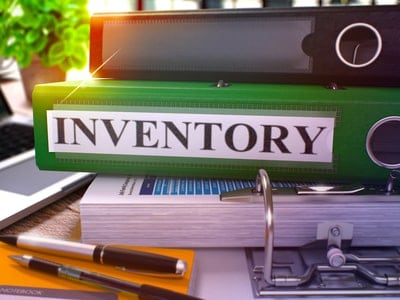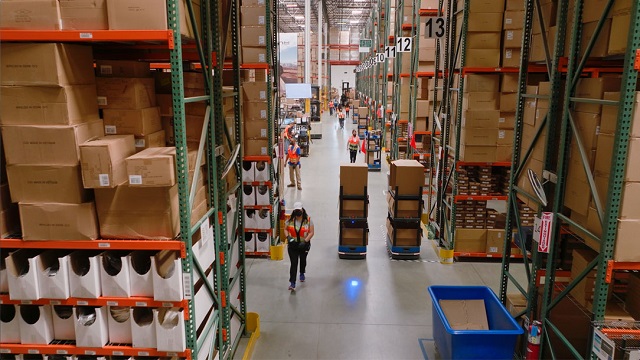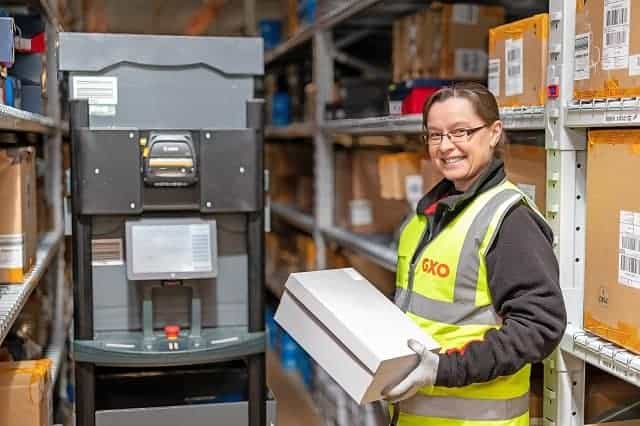With customers expecting lightning-fast order fulfillment times, there is a growing need to streamline and optimize warehouse operations. Inventory replenishment is an indispensable part of warehouse operation management that controls the efficient flow of goods throughout an entire supply chain (and thus, greatly affects fulfillment times).
In this guide, we’ll discuss the important components of warehouse inventory replenishment, including the various inventory replenishment models, lot-sizing methods, inventory replenishment systems and best practices for inventory replenishment:
- Definition of inventory replenishment
- Goals of inventory replenishment
- Inventory replenishment models
- Lot-sizing methods
- Inventory replenishment systems
- Best practices for warehouse inventory replenishment
Definition of inventory replenishment

Essentially, inventory replenishment is a combination of models, practices, and technologies that help manage the movement of stock from a central location to another location downstream to ensure that stock continues to flow efficiently along the supply chain. Also known as stock replenishment, inventory replenishment aims to use the most efficient methods to move inventory from reserve to primary storage and from the latter to picking locations.
Goals of inventory replenishment
The subject of inventory replenishment is a hot topic for all warehouses, particularly busy facilities that handle large volumes and companies that maintain a selection of products for multiple store locations and fulfillment centers. Done right, inventory replenishment can help warehouses:
- Avoid excessive overstock which results in increased carrying/storage costs
- Ensure on-time deliveries
- Minimize labor costs
- Cut back on dead stock and slow-moving items
- Reduce the risk of logistical problems.
- Improve replenishment planning
- Meet demand without shortages
- Maintain adequate safety/buffer stock levels
Inventory replenishment models

Inventory replenishment models and methods help businesses determine and manage replenishment frequency, establish inventory slotting best practices, track the flow of products, calculate the quantity of items to order, and determine the optimum level of inventory to be maintained in warehouses for maximum supply chain efficiency. These are mathematical models that help warehouse managers determine what quantity of products to reorder at predetermined intervals. Let’s take a look at some of the more popular replenishment models.
Min/max inventory replenishment
Also known as the “routine” method, the min/max replenishment model triggers restocking activity when a certain product reaches a predetermined minimum threshold. This is best used for SKUs with predictable throughput and seasonal demand that can be predicted using historical data.
In this model, inventory levels are continuously reviewed and when they reach a preset level (reorder point), replenishment orders are placed. While the ordering costs associated with this replenishment model are negligible compared to other expenses, carrying costs are usually high, and more space may be needed for both upstream storage and downstream picking areas.
Demand inventory replenishment
The demand inventory replenishment model makes sense for warehouses with limited space and picking locations. It is best used in situations where it’s inefficient to dedicate significant space to any single item. In demand replenishment, the replenishment quantity should be just enough to fulfill a pending order or group of orders without leaving excess stock behind.
Top-off inventory replenishment
The top-off replenishment model uses similar min/max thresholds as the min/max replenishment model and usually runs on set schedule or batch released (by area, line or product). The inventory for a specific product is “topped-off” to acceptable levels in picking areas or forward pick locations based on projected demand or shift in the number of available staff.
This model works well when large waves of picking work or picking volume is expected. It’s best used when picking operations are less active or when there are work shortages. Having a system that triggers top-off replenishment when variations in picking work or volume is expected promotes interleaving opportunities in active areas.
Periodic inventory replenishment
In warehouses where periodic replenishment models are used, the amount of inventory needed for certain intervals (based on demand forecast) is moved to picking locations. The end of these intervals are typically used as review points and the amount of inventory in stock is checked at these points. If stock levels fall below the minimum threshold, replenishment orders are placed. Otherwise, they are skipped until the next review point.
As such, this model is associated with longer lead times and should be used when there is a large storage area for products (because inventory is moved in large volumes to picking locations). On the flip side, carrying costs are typically negligible compared to ordering costs while ordering costs are typically independent of order volume.
Identifying the right mix of replenishment models
Choosing the right replenishment model is essential for efficient operations. Although each replenishment model has its pros and cons, using the wrong model can turn replenishment operations into a nightmare for warehouse managers and finance executives. In some cases, using a mix of replenishment models is the best way to achieve optimal balance between inventory levels and consumer demands.
Achieving this balance may require warehouses managers to use a combination of replenishment models for different product lines, during periods of seasonal demands or even for the same product at the same time.
Lot-sizing methods
Lot-sizing methods are usually determined by the trade-off between the ordering costs from the supplier and the carrying costs of the SKU. It’s used to establish optimal order quantities for both reorder point strategy and periodic replenishment models. The following are various lot-sizing methods that can be used for inventory replenishment activities.
Fixed order quantity
This is the simplest lot-sizing technique. A specific amount of a product is ordered at one time. Surplus inventory in a particular period must be consumed in future periods before a new order is placed.
Economic order quantity (EOQ)
Economic order quantity (EOQ) is used to describe the order quantity that minimizes both total ordering and holding costs. It is the quantity of a SKU that should be added to inventory with each order placement to minimize holding, shortage and order costs. The EOQ is a valuable tool and provides a model for accurately determining the optimal reorder quantity and appropriate reorder point to prevent stocks from running out.
Lot-for-lot (LFL)
Also referred to as discrete order quantity, lot-for-lot provides a model for determining the quantity of a product that should be ordered to meet demand requirements for a specific period. It’s best used in situations where demand for an item fluctuates widely.
Periods of supply (POS)
This establishes the quantity of a product that should be ordered to meet demand requirements for a defined number of periods. Periods of supply is very similar to the lot-for-lot model — the only difference is that the latter concerns itself with just one period while the former deals with multiple periods.
Period order quantity
The period order quantity uses EOQ to calculate the specific number of periods that should be covered in an order
Essentially, EOQ/Avg = POQ.
Least unit cost
The least unit cost lot-sizing technique determines the best ordering quantities based on the effect of cumulative needs over time. In this method, the inventory carrying and ordering costs for each possible lot size is added and divided by the total number of product units in that lot size. Choose the lot size whose unit cost is the lowest.
Least total cost
The least total cost technique helps calculates order quantities by comparing the ordering and carrying costs for several lot sizes. The lot size where these costs are nearly equal is what is purchased.
Part period balancing
This technique computes order quantities by determining the total demand sum up to the period when carrying costs and ordering costs for the item are most balanced. Part period balancing is a dynamic lot-sizing technique that works by first calculating order quantities (using the least total cost method) and then looking ahead/back to see if grouping periods together reduces the overall ordering and carrying cost.
Types of inventory replenishment systems in warehouses

Most large businesses that sell or manufacture tangible goods have to manage and track hundreds, if not thousands of products. It’s easy for human operators to miss key indicators that point to seasonal changes in demand, change in consumer preferences and out-of-date products, leading them to order inventory at the wrong time or in sub-optimal quantities.
As such, a lot of operations managers resort to legacy applications in an attempt to optimize replenishment activities. Most of these systems do not have functionalities like demand forecasting, custom alert notifications, inventory management and demand planning. Some managers may even use spreadsheets to attempt a manual calculation of demand forecasts — an arduous, time-consuming replenishment process that greatly increases error margins.
To maintain optimum inventory levels, there is a need for accurate demand forecasting and planning systems to predict future sales and ensure sufficient inventory levels without increasing ordering/carrying costs and running the risk of stock-outs or obsolescent stock. This requires the use of inventory replenishment systems, such as those outlined below.
Enterprise resource planning
Enterprise resource planning solutions (ERPs) typically come with inventory management capabilities, making it easy to organize stock, track the movement of SKUs through the supply chain, intelligently improve picking and packing processes and manage inventory replenishment.
The latter functionality allows businesses to create replenishment rules that trigger the creation of economic order quantity (EOQ) orders when inventory levels reach the reorder point. If the warehouse uses the min/max replenishment model for a SKU, restocking activity is triggered when the minimum level is reached. Order quantities are determined by subtracting the max quantity from the min quantity.
While ERPs are essential tools for effective warehouse management, they should be paired with other systems to optimize replenishment operations. Without accurate demand projections, companies end up with stockouts, back orders or excess inventory — a major problem for seasonal inventory with high carrying costs. As such, ERP systems should be integrated with demand forecasting and planning solutions to gain insight into incoming inventory and define accurate/effective reorder points.
Warehouse management systems
Replenishment modules in warehouse management systems allow operations managers to set individual reorder amounts per product item. Once the number of products drops below the minimum threshold, the system automatically initiates the protocol to replenish that item. This keeps inventory levels stable (even during periods of high sales volumes). However, this process works best when the WMS is paired with real-time data capture and scan validation.
The availability of real-time, accurate data supports better demand forecasting, leading to optimized replenishment activities. As orders are picked from forward-pick locations, replenishing from overstock helps avoid delays and maintain inventory accessibility for pickers (based on established replenishment model). One of the cons of using such systems is excess labor utilization, particularly in cases where overstock is moved too early or frequently.
Warehouse execution systems
Warehouse execution systems (WES) offer heightened visibility, dynamic order releases, and better replenishment execution/management than most traditional warehouse management systems. WES solutions can either be paired with a WMS or used on their own to gain better visibility of product movement as they travel through the supply chain. Better still, dedicated execution and management of inventory replenishment is a core function of a WES.
This functionality is ideal for warehouse/distribution center operations that move a wide range of SKUs and have limited warehousing space. The WES sends real-time notifications to operations managers when pallets flow forward and pallet space becomes available.
Also, the aggregated data in WES solutions can be used to create algorithms that send custom alerts on the status of replenishment space for slow-moving SKUs. Lastly, warehouse execution systems can also manage picking systems (especially collaborative robots or machine-controlled systems) thus removing the need for a WMS solution.
Best practices for warehouse inventory replenishment

As today’s on-demand global market continues to evolve and become more competitive, the efficiency of warehouse replenishment operations plays a major role in determining whether a business succeeds or fails. Ensuring seamless product delivery to customers requires operations managers to adhere to the following best practices when it comes to warehouse inventory replenishment.
Automate your inventory replenishment processes
Automated inventory replenishment trumps manual replenishment processes every time. The latter is time-consuming, arduous, prone to errors and can result in prolonged stockouts, backorders, and excess inventory. Also, determining reorder points and order quantities for effective inventory replenishment depends largely on accurate demand forecasting, an activity that’s nearly impossible to execute manually. Companies should consider upgrading to robust logistics solutions with inventory replenishment optimization and automation functionality.
Consider your business’s unique needs
Knowing how much inventory to order to bring warehouse stock up to optimal levels depends largely on the type of replenishment model in use. This, in turn, depends on the size of operations, type of product, seasonal fluctuations and demand forecast.
It’s best to use a model (or mix of models) that’s tailor-made to meet the unique needs of the warehouse and supply chain. Such a model will help ensure that warehouses never run out of stock while also ensuring that surplus inventory is kept at manageable levels.
Monitor and measure your vendors’ performance
Aside from ensuring accurate demand forecasting and automating inventory replenishment, businesses need to monitor the performance of their vendors. Poor vendor performance, late deliveries and unacceptable lead times can undo all the benefits of automated inventory replenishment. As such, monitoring and measuring vendor performance is vital to the success of replenishment efforts. Companies should identify and stick with vendors that deliver orders on time, accommodate flexible order quantity requirements and offer discount pricing on volume purchases.
Consider the unique needs of each of your warehouses
For businesses that deal with numerous SKUs and have multiple distribution facilities, the ability to balance inventory across the network is key to logistics success. Setting up processes and systems to optimize and streamline inventory redistribution activities for multi-location operations delivers substantial benefits. It helps reduce the frequency of overstocking and stock-outs, mitigates the risk of stock obsolescence, improves income and profit margins and drives better capacity utilization.
Also, multi-channel distribution centers need to create rules and policies to prioritize the allocation of inventory. For best results, companies should leverage solutions with the ability to virtually allocate inventory to different channels.
Leverage ERP systems to automate replenishment processes
Replenishment managers need all the help they can get as they walk the fine line between stockout and oversupply. Oversupply of SKUs locks down space and company resources while the depletion of a top-selling product can result in millions of dollars in lost revenue. The best way to maintain a steady flow of inventory is automating replenishment processes — something that ERP systems are particularly good at. These systems automatically trigger re-order/restocking activity when stocks reach a predetermined minimum threshold. This way, there is less chance of out-of-stock items and backorders.
The main goal of inventory replenishment is to ensure that the quantity of SKUs remain at optimum levels and that items are seamlessly rotated into pickable location in line with demand forecasts to avoid delays and reduce the risk of inaccessible inventory. While this appears to be an easy undertaking, inventory replenishment can become very complicated for average to large warehouses that move a lot of different products.
When stocks run out or can’t be located quickly, fulfillment workflows break down, increasing the difficulty and inefficiency of supply chain operations. To reduce the frequency of stock-outs, optimize ordering and carrying costs and improve all-round efficiency of warehouse operations, operations managers should optimize inventory replenishment by identifying and leveraging the right mix of inventory replenishment models, processes and solutions.
Interested in more? Let’s discuss the solution that’s right for you. Contact us today.


